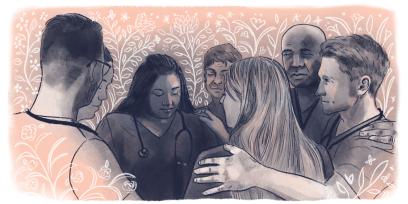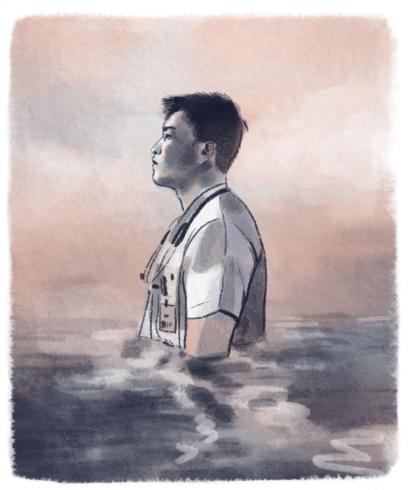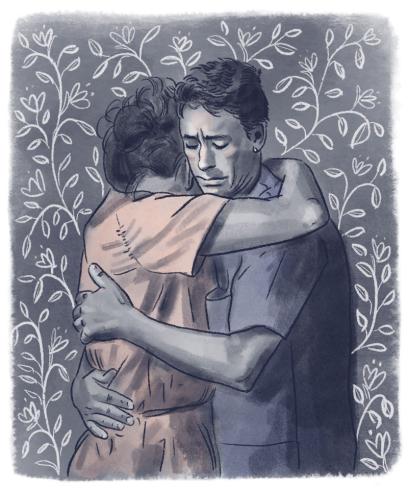Every year, tens of thousands of aspiring doctors, nurses, and other healthcare professionals immerse themselves in US educational and training programs, eagerly preparing for their roles as healers. In Pennsylvania in the 1980s, Rosalind Kaplan was one of them. And, like many others, she was sometimes shocked by the emotional impact of the traumas she encountered—gunshot wounds, stabbings, failed resuscitations. She vividly recalls one night as a resident on the hematology/oncology service when an elderly, extremely weak patient receiving chemotherapy experienced a massive gastrointestinal bleed; she had to perform CPR on him as he was bleeding out in the radiology suite. “He died alone, on a cold metal table, and I started imagining what that would be like,” she said. When she began telling the attending physician what had happened, she started to cry.1
Although little research has been done on the impact of grief or trauma among healthcare professionals, a 2017 study of a small group of Canadian oncologists found that they experienced difficulty with the deaths of their patients, particularly those they considered young, long-term, or unexpected.2 The bedrock for this study came from a previous study, which found that oncologists demonstrated sadness, crying, and loss of sleep, along with feelings of powerlessness, self-doubt, guilt, and failure.3
Leeat Granek, a critical health psychologist and associate professor at York University in Toronto who coauthored both of the studies, was inspired to initiate the research after her mother died of metastatic breast cancer. “I knew I was feeling something,” said Granek, whose mother had received treatment from her healthcare team for nearly 20 years. “And I found myself wondering, what’s going on for them?” Granek found that in addition to regular feelings of grief, oncologists reported that they often felt responsible. “There’s kind of this intellectual understanding that yes, you did everything that you could,” Granek said. “But emotionally the feeling is, I’m supposed to cure this patient and they died. And I feel like a terrible failure that they didn’t make it.” Granek said it’s essential for healthcare systems to begin normalizing and validating feelings of grief and loss among practitioners. “Acknowledgment would remove the stigma from the individual person and recognize that it’s part of the work that people do,” Granek said.
Learning to Acknowledge Grief and Trauma
Sherry Lynn Jones, a former paramedic and ER nurse with a PhD in education, came to a similar conclusion regarding trauma. “We have expectations as paramedics that we’re going to go out there and … make a difference,” said Jones, who started out as an EMS volunteer in her small Michigan town in the late 1980s, serving community members she often knew personally. “We’re not trained in how to handle it when things go wrong.”
Early on in her career, Jones began working with the International Critical Incident Stress Foundation, doing stress management interventions with people in emergency services. “Because we also gave them information about preparedness and education, they did not respond so badly after that,” Jones said. “You can inform and educate, and people know that these things are going to happen.” But such education isn’t common. As Jones pursued her interest in nursing education, her dissertation research4 confirmed that there is a significant lack of formal training related to grief, trauma, and resilience.
“Most of Us Never Talk About It”
Chris Poole, who after 10 years as an acute care nurse maintains an aura of unflappable calm, works on the medical-surgical floor at the University of California, San Francisco (UCSF). Poole considers himself highly fortunate to work at a California hospital, where state law not only limits nurse-patient ratios but also mandates a break nurse, so that staff can actually take time to sit down. Still, he experiences difficult emotions around some patients, such as the 50-year-old woman with inoperable, metastasized cancer with her children in tow. “It can bring tears to your eyes, and these patients can stay with you,” said Poole. “It’s probably not the healthiest thing, but there’s a lot [of emotion] there under the surface.”
Poole will sometimes discuss particularly difficult cases with his mother, who was also a nurse, but acknowledges that other means of processing would be helpful. While there are some support groups available to nurses at UCSF, Poole said that because he lives about 40 minutes away in Berkeley, he wouldn’t attend on his days off. “I’m sure it would be good to get together with other nurses and talk, because we all experience this,” he said. “But most of us never talk about it.”
In her research, Granek found that this was common. “Everybody’s feeling the same way, and saying the same things, but they’re not talking to each other,” Granek said. A 2017 study of oncologists in both Israel and Canada revealed that the top desire for these specialty physicians coping with terminal patient illnesses was simply the validation of their grief and other related emotions. In addition, they also expressed interest in lectures, seminars, trainings, group debriefings, and most importantly the opportunity to take time off.5 “There’s a huge variation in terms of what people found helpful in coping with these emotions,” Granek said, who advises that institutions provide a range of interventions and make these offerings opt-out rather than opt-in to normalize their necessity.
Disenfranchised Grief
Doctors, nurses, paramedics, and others who work closely with illness and death have to find their own ways to navigate and process occupational grief while remaining as available as possible to the needs of their patients. And depending on their individual makeup, their work and home environments, their support systems, and other factors, this exposure can, over time, profoundly affect their mental and emotional well-being.
The fact that patient deaths affect clinicians differently is something that Alexandra Jabr, a paramedic educator in the Los Angeles area with a master’s in mental health specializing in grief and bereavement, has often witnessed in the field. Jabr spent about 15 years as an active paramedic and now teaches aspiring paramedics in community colleges and counsels fire departments on occupational resilience, behavioral health, and death communication. “The way I respond to a child dying is different from the way a parent is going to respond,” Jabr said. Instead, Jabr found herself reacting strongly to a young couple who’d suffered a car accident in which the husband died at the scene and his wife waited for hours on the side of the road. “It was heartbreaking because we were the same age,” Jabr said. “It was just the association that changed for me, and I never quite forgot that.”
When such emotions are not dealt with and processed, they can accumulate—with devastating consequences. When asked how first responders process grief, Jabr said, “I don’t think they do.” She often discusses disenfranchised grief—grief that’s not openly acknowledged, socially validated, or publicly mourned—with the firefighters and paramedics she educates, and she found that one man was “just blown away” when the concept explained why he’d felt sad or upset over patient deaths—emotions he’d previously dismissed, telling himself he hadn’t known the person.
Kenneth Doka, a leading researcher in the field of grief and loss who coined the term disenfranchised grief in 1985, said that healthcare workers experiencing patient deaths would fall into the category of disenfranchised grief where a relationship isn’t recognized.6 Noting that some institutions are better than others at recognizing and acknowledging the grief experienced by clinicians, Doka added that healthcare workers can also disenfranchise themselves for various reasons, such as the belief that becoming attached conflicts with their professional role. To better support their staff and prevent burnout, occupational stress, and turnover, healthcare organizations “need to provide support, education, and sometimes ritual” to process patient deaths, he said.
Don Dizon, the director of women’s cancers at Lifespan Cancer Institute and director of medical oncology at Rhode Island Hospital, said that writing about grief-laden experiences on his blog and on social media has been a “godsend” to processing his emotions. While he posts more for himself than for others, Dizon also benefits from colleagues who resonate with and respond to his words. “You realize that the experience, even though it’s painful, is one that other people have also experienced,” he said. “And then that sense of isolation goes away.” For similar reasons, Dizon enjoys participating in Schwartz Rounds at his hospital, a program created by the Schwartz Center for Compassionate Healthcare that offers healthcare workers—including security guards, phlebotomists, and any other professionals who might interact with a patient—regularly scheduled times to discuss the social and emotional aspects of a patient’s case with others in the field.* Dizon always finds himself disappointed by the low physician turnout. “It’s a missed opportunity,” he said. “So many of us suffer silently, and I think trying to go beyond that is still a challenge.”
Shared Humanity
Children mangled by car accidents, young mothers succumbing to cancer, unexpected deaths in the operating room: the list of traumas experienced by medical professionals is long and varied. Many healthcare workers find themselves deeply affected by their patients’ tragic circumstances and shoulder an increasingly heavy burden of unresolved grief. But some are beginning to embrace innovative ways of coping. Perhaps surprisingly, many of these efforts involve finding greater connection with patients who are dying, as well as seeking support from therapists, chaplains, and the larger faith community. By recognizing and honoring the humanity of those they serve, many healthcare professionals find that they are able to mitigate their distress about the suffering and death they’re forced to witness daily.
Roughly a decade ago, Jonathan Bartels was working as a trauma nurse in the University of Virginia Health System when he was inspired by a chaplain who asked everyone to stop after a patient’s death and said a prayer. While Bartels didn’t relate to the religious nature of her prayer, he was struck by the power of the concept and translated it into “the Medical Pause,” which uses secular language to call for a moment of silence.7 “You can have someone who’s Christian next to someone who’s Hindu next to someone who’s Buddhist, and someone who’s atheist or agnostic, all honoring that patient but doing it in silence,” he said. “But all with the same mission—which is really to take a moment to recognize this last rite of passage. To reinstate ritual … back into a system that has driven ritual out through its scientific pursuits.”
Bartels said that he witnessed an immediate difference when experiencing the trauma of code blues and other patient deaths. “I didn’t just separate, I was able to close the gap from one act to another, and I was able to put [the trauma] down,” he said. “And then my peers were able to put it down. But it’s not—and I say this often—it’s not a panacea, it’s not a cure-all. This is the first step in many, many steps of what is really being called for to take care of ourselves.”
As Bartels found, ritual doesn’t need to be elaborate to be effective. “The biggest difference was the way people left that room,” Bartels said. While clinicians will typically toss their gloves on the floor, along with the equipment and blood, and walk out, the Pause allowed them to reconnect and leave with a sense of reverence. “This really changed things because we could stop to honor that person, and not walk away disappointed,” he said.
Such moments are powerful. Pulmonary critical care and palliative care–trained physician Jessica Zitter vividly recalls the first time she witnessed an ER resident implement a moment of silence following a patient’s death. It was only a few years ago—something the resident had been taught in her training. “I was blown away,” Zitter said. “I was so touched and moved, and I thought, why haven’t we done this before? This is exactly what we need to do when a person’s life passes through your hands.” Since then, Zitter has continued the practice. “This is very big stuff, and it should be meaningful,” she said. “The second we stop seeing it as meaningful and human and poignant and sad and connecting, that’s when we start to lose our humanity.”
Moving Toward Systemic Change
Healthcare is just one of the numerous US systems—along with social services and housing, among others—that the COVID-19 pandemic revealed to be severely lacking in humanity. But healthcare workers have been dealing with the fallout of a detached and uncaring system for decades. The widespread lack of support for grief and trauma extends well beyond patient deaths and medical trauma to unrealistic work hours and schedules, escalating workplace violence, bullying, and other forms of mismanagement and abuse.
Integrating grief and trauma for healthcare workers must begin in training and continue as an essential component throughout their careers—including varied offerings such as Schwartz Rounds, International Critical Incident Stress Foundation interventions, debriefings, coaching, and confidential and nonpunitive access to mental health services. No matter how much healthcare organizations might wish otherwise, there is no single solution—no silver bullet, no magic wand. Self-care trainings can be helpful, but they should be provided on paid workdays and acknowledge time constraints and other issues. Most importantly, such approaches simply cannot replace the need for widespread governmental, systemic, and institutional reform; improved staff support; and more reasonable work schedules, implemented with direct feedback from healthcare workers at all levels. More often than not, staff recognition is reduced to a pizza party or a coffee mug—minimal gestures that fail to recognize or address the traumatizing and grief-inducing circumstances they confront on a daily basis. Such token measures won’t be enough.
The pandemic established a unique window into the challenges and sufferings of US healthcare workers at all levels of a malfunctioning system. Having absorbed this view, perhaps we can make the adjustments necessary to better support one another, to move toward a future that is more sustainable, more just. Not only for healthcare workers, but for all of us who will inevitably fall ill, suffer, and die—hopefully, with the best assistance possible at our bedsides.
Rachel Jones, MS, is a staff writer for SevenPonds, a website focusing on an array of issues related to end of life. A former correspondent for the Associated Press, her work has appeared in Time magazine, The Lancet, Scientific American, and many other publications. This article was excerpted from Grief on the Front Lines: Reckoning with Trauma, Grief, and Humanity in Modern Medicine by Rachel Jones, published by North Atlantic Books, copyright © 2022. Reprinted by permission of publisher.
*The center launched Schwartz Rounds to provide healthcare workers with a forum to discuss the social and emotional issues of patient care, and they’re now offered at hundreds of hospitals and other healthcare organizations around the world. Those who participate report improved teamwork and communication, lower rates of stress and isolation, and greater feelings of compassion toward patients. (return to article)
Endnotes
1. Quoted material and personal stories are from the author’s interviews.
2. L. Granek et al., “Experiences of Canadian Oncologists with Difficult Patient Deaths and Coping Strategies Used,” Current Oncology 24, no. 4 (2017): 277–84.
3. L. Granek et al., “Nature and Impact of Grief Over Patient Loss on Oncologists’ Personal and Professional Lives,” Archives of Internal Medicine 172, no. 12 (2012): 964–66.
4. S. Jones, “Nurses’ Occupational Trauma Exposure, Resilience, and Coping Education,” PhD diss., Walden University, 2016, scholarworks.waldenu.edu/dissertations/2360.
5. L. Granek et al., “Oncologists’ Negative Attitudes Towards Expressing Emotion Over Patient Death and Burnout,” Supportive Care in Cancer 25 (2017): 1607–14.
6. K. Doka, “Disenfranchised Grief,” paper presented to a symposium on Death Education of the Foundation of Thanatology, New York, April 25, 1985, drkendoka.com/privacy-policy; and K. Doka, “Disenfranchised Grief in Historical and Cultural Perspective,” in Handbook of Bereavement Research and Practice: Advances in Theory and Intervention, ed. M. Stroebe et al. (Washington, DC: American Psychological Association, 2008), 223–40.
7. J. Bartels, thepause.me.
[Illustrations by Gabriella Trujillo]



